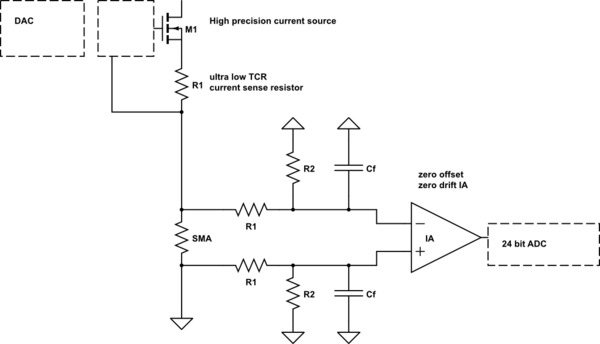<!-- Begin schematic: In order to preserve an editable schematic, please
don't edit this section directly.
Click the "edit" link below the image in the preview instead. -->

<!-- End schematic -->
It might be simpler to make a high precision current source, rather than measure the current. You could be using the same voltage reference for DAC,ADC and current reference. The instrumentation amplifier shall have all resistors with ultra low TCR.
EDIT:
Version 2. More complex, but AC:
<!-- Begin schematic: In order to preserve an editable schematic, please
don't edit this section directly.
Click the "edit" link below the image in the preview instead. -->

<!-- End schematic -->
You do use a transformer and triac phase control. At very low conducting angle we cold say:
$$sin \ \omega t\approx tan\ \omega t \approx \omega t$$
Therefore
$$V_{SMA}sin \ \omega t\approx V_{SMA} \omega t$$
$$R_{SMA}=\dfrac{\Delta V_{SMA}}{\Delta I_{SMA}} = \dfrac{V_{SMA} \omega T_1}{I_{SMA} \omega T_2}$$
Instead of using ADC, you could be using a capture input to measure pulse time coming from window comparator. The window shall be adjusted so that sine wave is at very end of cycle, let say 0.5ms before zero cross. You do control the triac and you fire at each second a short pulse, to take the reference reading. Then you measure times each cycle, you increase conduction angle and you compute the \$\Delta R/R\$.
$$V_{comp_V}\approx V_{ref}\omega T_{Vref}$$
$$V_{comp_V}\approx V\omega T_{V}$$
$$\dfrac{V}{V_{ref}}=\dfrac{V_{comp_V}\omega T_{Vref}}{V_{comp_V}\omega T_{V}} = \dfrac{ T_{Vref}}{T_{V}}$$
$$\dfrac{I}{I_{ref}}=\dfrac{V_{comp_I}\omega T_{Iref}}{V_{comp_I}\omega T_{I}} = \dfrac{ T_{Iref}}{T_{I}}$$